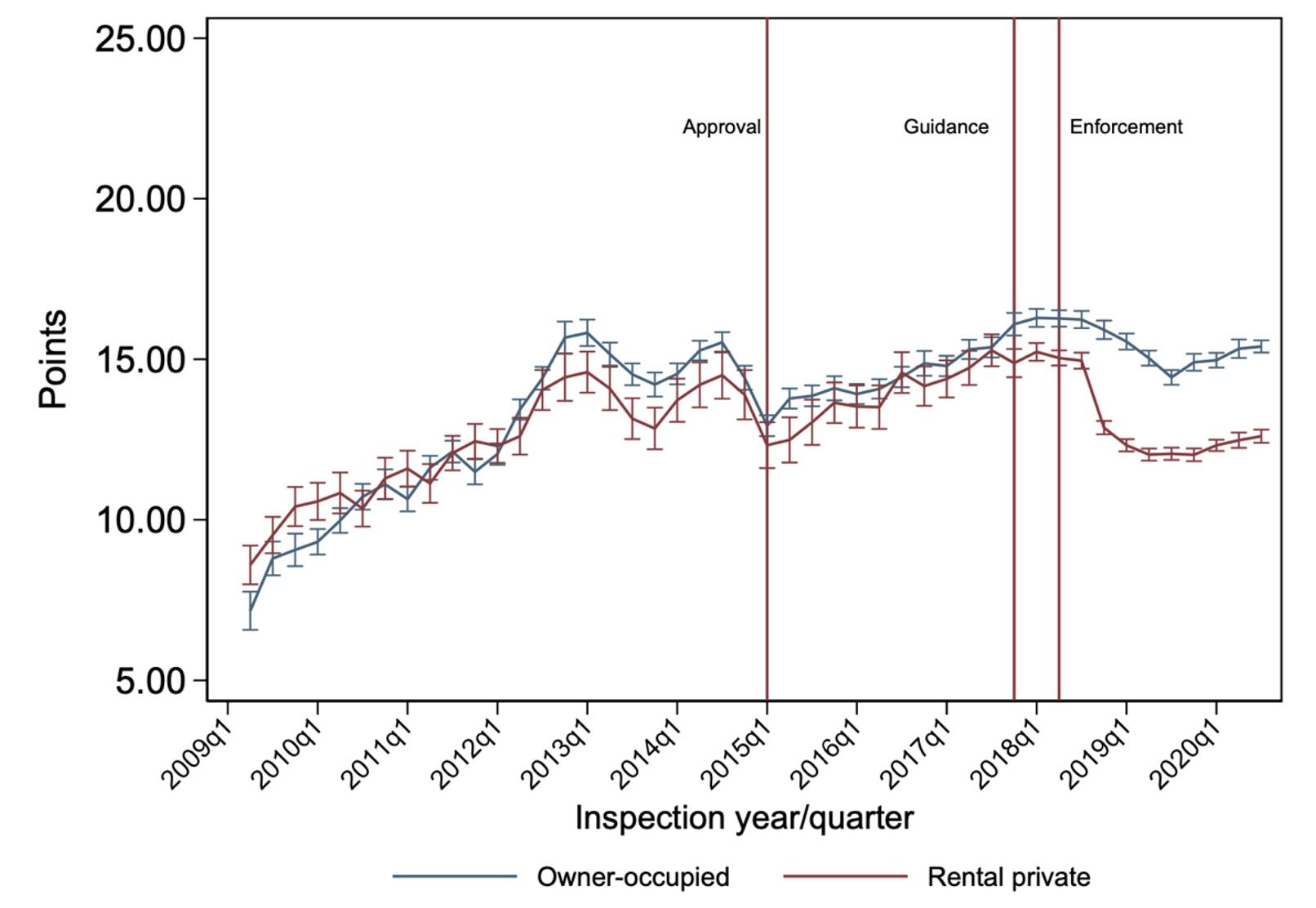Governments around the world are tackling climate change in various sectors, often relying on targeted regulations to reduce carbon emissions. One critical sector is residential buildings, which is responsible for approximately 22% of global energy consumption and 17% of greenhouse gas emissions (United Nations Environment Programme 2020). Government interventions in this sector frequently revolve around regulations that mandate a minimum level of energy efficiency in buildings, often accompanied by subsidies (Fowlie et al. 2018, Hahn and Metcalfe 2021, Hausman and Joskow 1982, Allcott and Greenstone 2017). These policies aim to enhance both energy efficiency and environmental performance by targeting a subset of the sector. Therefore, understanding the efficacy of such policies is of first-order importance for both policymakers and academics, as it sheds light on the nature of energy-efficiency investments made by households in response and the policies’ effectiveness for tackling climate change.
In our paper (Clara et al. 2022), we address this question by examining the Minimum Energy Efficiency Standard (MEES) introduced in the UK. The Standard mandates minimum energy efficiency standards for rented residential properties in England and Wales, requiring all such properties to achieve an Energy Performance Certificate rating of at least band E by April 2020. Energy Performance Certificates provide a composite numeric rating on a scale from 1 to 100, indicating a property’s energy efficiency, which are a function of the associated operating costs. The numeric rating is converted to a letter rating, with A representing the most efficient and G the least efficient. This regulation in effect prohibits properties with a rating of F or G from establishing or renewing tenancies until energy improvements are made to achieve an E rating. (Listed properties are exempt since aesthetic norms restrict the retrofits that owners may undertake [Fetzer 2023].)
We compile data for nearly 14 million unique properties in England and Wales from 2008 to 2021, which includes both rental and owner-occupied properties. Our initial analysis focuses on understanding the rationale behind the regulation’s emphasis on renters rather than homeowners. When we compare rental properties to owner-occupied ones, we observe that the former are generally more energy-efficient. However, this masks substantial heterogeneity in the type of properties in each group. For instance, rental properties are more likely to be condominiums or flats, which typically have fewer external walls and are, therefore, more energy-efficient compared to houses more commonly owned by homeowners.
Once we account for property type, we find that rental properties, on average, tend to be less energy-efficient than owner-occupied properties of the same type. This suggests that prior to the introduction of regulations, rental properties might have been underinvesting in energy efficiency.
One key advantage of the Energy Performance Certificates is that, for some properties, we have multiple certificates, allowing us to track investments made between any two pairs of certificates. Additionally, these certificates provide information on indicative capital expenditures and the associated savings resulting from these retrofits. These data allow us to offer new insights into the nature and financial viability of the investments made by households in response to the regulations.
Within the subset of properties with multiple certificates, we observe that the regulation improved energy efficiency for rental properties relative to owner-occupied properties (Figure 1). Moreover, it spurred investments, particularly in areas like lighting, main heating controls, and pitched roof insulation.
Figure 1 Changes in energy efficiency around the Minimum Energy Efficiency Standard regulations
Using the information on savings and capital expenditures, we calculate the internal rates of return on these investments for various discount rates, as suggested by prior research. Our analysis reveals that these retrofits typically yield a higher internal rate of return on investment and require lower initial outlays. An exception is the installation of double glazing for windows, which is a common investment despite its comparatively lower financial attractiveness. This suggests that homeowners and landlords may be motivated by factors such as improved home comfort (e.g. noise reduction) or enhanced aesthetics. Overall, our analysis offers novel, large-sample evidence regarding the types of retrofits undertaken by both homeowners and landlords.
An immediate question that arises is whether landlords increase rents to recoup their investments in response to the regulation. To better understand whether this is indeed the case, we combine the Energy Performance Certificates with listing data. Focusing on properties listed for rent, we find that landlords who made investments to comply with the Minimum Energy Efficiency Standard are associated with an average rent increase of approximately 1%. Furthermore, when we compare the estimates of capital expenditures to the increase in rents, we find that investments in most retrofits do not fully offset the substantial initial costs, even after accounting for the standard rental market adjustments due to inflation. This suggests that landlords perhaps may not have made these investments without the regulatory intervention.
Finally, we investigate how the investments made in response to the regulations are related to the secondary objective of reducing carbon emissions from residential buildings. To do this, we again leverage the granularity of the Energy Performance Certificates and the composite numerical scores, ranging from 1 to 100, on the environmental performance of buildings. This score reflects the type and quantity of energy used in the operation of the building and the associated carbon emissions based on the energy sources. Our findings show that improvements in energy efficiency for rental properties, compared to owner-occupied ones, were not accompanied by similarly substantial improvements in environmental performance (Figure 2).
Figure 2 Changes in environmental performance around the Minimum Energy Efficiency Standard regulations
This divergence between energy efficiency and environmental performance can be attributed to two key factors. First, energy efficiency primarily emphasises cost reduction by optimising energy consumption and favouring cost-effective energy sources. In contrast, the carbon footprint not only considers energy consumption but also factors in the carbon emissions associated with energy sources. Consequently, while the regulations successfully motivated landlords to invest in energy-efficient measures, their primary motivation was cost reduction rather than a transition to cleaner energy sources.
Second, the tension between policies addressing energy consumption and those targeting energy production within energy markets results in a disconnect between energy efficiency and carbon emissions. For example, the introduction of a carbon tax on electricity production in the UK in 2013 led to a significant reduction in coal-based electricity and increased use of gas and renewables. However, this shift may have resulted in higher electricity prices as additional costs were passed on to consumers. This, in turn, made properties using electricity as their primary fuel source less energy-efficient due to the increased costs incurred.
In conclusion, our analysis indicates that regulations with multiple intertwined goals – which, like the Minimum Energy Efficiency Standard, aim to address various objectives within the context of externalities – may not achieve their desired effectiveness. Our study underscores that cost-based regulatory interventions are less likely to accomplish their secondary objective of reducing carbon emissions. Instead, coordinated policies targeting emissions directly on both the consumption and production sides may offer a more effective approach to addressing the climate challenge in the residential sector. When implementing coordinated policies, however, the political feasibility of the policies will need to be considered (Paoli and van der Ploeg 2021).
References
Allcott, H, and M Greenstone (2017), “Measuring the welfare effects of residential energy efficiency programs”, National Bureau of Economic Research.
Clara, N, J F Cocco, S L Naaraayanan, and V Sharma (2022), “Investments that make our homes greener: The role of regulation”, SSRN 4009054.
Fetzer, T (2023), “The environmental burden of aesthetic norms”, VoxEU.org, 8 October.
Fowlie, M, M Greenstone, and C Wolfram (2018), “Do energy efficiency investments deliver? Evidence from the weatherization assistance programme”, Quarterly Journal of Economics 133(3): 1597–644.
Hahn, R W, and R D Metcalfe (2021), “Efficiency and equity impacts of energy subsidies”, American Economic Review 111(5): 1658–88.
Hausman, J, and P Joskow (1982), “Evaluating the costs and benefits of appliance efficiency standards”, American Economic Review 77(2): 220–25.
Paoli, M C, and F van der Ploeg (2021), “Recycling revenue to improve political feasibility of carbon pricing in the UK”, VoxEU.org, 2 August.
United Nations Environment Programme (2020), The 2020 global status report for building and construction: Towards a zero-emission, efficient and resilient buildings and construction sector.









